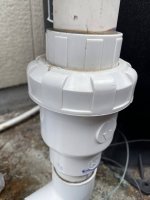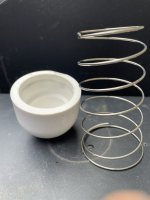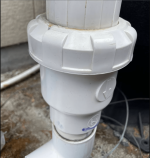Good afternoon,
Last season I bought and installed a 2" check valve with the goal of keeping the solar drain-down from upsetting the sand filter bed. I bought it at a local plumbing supply shop... not thinking that there may be specialized pool products better suited for the job.
I fired up the pump and the valve makes a loud clicking / knocking sound... somewhere around maybe 10 Hz. Very disruptive of pool enjoyment.
Thank God the thing came with a built-in union. I popped it open and removed the spring and half ball. It's only detriment now is maybe an undetectable bit of flow restriction. But I'd still like to have a check valve.
If I can't get this one to work, I may or may not be able to remove it. It's right below my Ecomatic solar cell housing with maybe just enough pipe left to put something else there, or perhaps a coupling, without sacrificing said expensive cell housing.
The only thing I can think to try is a stronger spring, if I can find one. The current one is very light duty. I'd be surprised if it was a half lb. And it's slightly funnel shaped.
Or do I need to just break down and buy a pool-specific check valve? If so, I do have enough pipe left further down the pressure-side line, but it will take some doing.


Last season I bought and installed a 2" check valve with the goal of keeping the solar drain-down from upsetting the sand filter bed. I bought it at a local plumbing supply shop... not thinking that there may be specialized pool products better suited for the job.
I fired up the pump and the valve makes a loud clicking / knocking sound... somewhere around maybe 10 Hz. Very disruptive of pool enjoyment.
Thank God the thing came with a built-in union. I popped it open and removed the spring and half ball. It's only detriment now is maybe an undetectable bit of flow restriction. But I'd still like to have a check valve.
If I can't get this one to work, I may or may not be able to remove it. It's right below my Ecomatic solar cell housing with maybe just enough pipe left to put something else there, or perhaps a coupling, without sacrificing said expensive cell housing.
The only thing I can think to try is a stronger spring, if I can find one. The current one is very light duty. I'd be surprised if it was a half lb. And it's slightly funnel shaped.
Or do I need to just break down and buy a pool-specific check valve? If so, I do have enough pipe left further down the pressure-side line, but it will take some doing.


Last edited:




